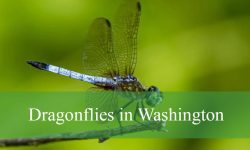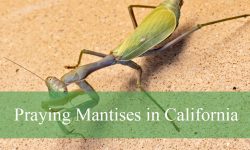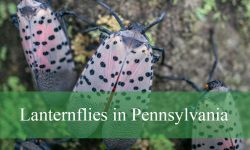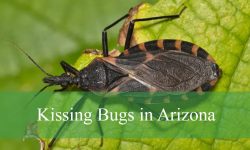In Kentucky can be found a fascinating variety of hummingbirds, from the familiar Ruby-throated Hummingbird to rare western visitors that occasionally wander into the state. These tiny birds mesmerize birdwatchers with their shimmering plumage, rapid wingbeats, and acrobatic flight.
Although only one species breeds regularly in Kentucky, several others appear as migrants or accidental visitors, bringing excitement to backyard feeders and natural habitats alike. Each species shows unique traits, behaviors, and migration patterns that make them remarkable to observe.
This guide explores six types of hummingbirds seen in Kentucky, providing identification tips, feeding habits, and fun facts. It is designed to help bird enthusiasts of all levels recognize and appreciate these extraordinary birds.
Common Hummingbirds Found in Kentucky
Ruby-throated Hummingbird (Archilochus colubris)
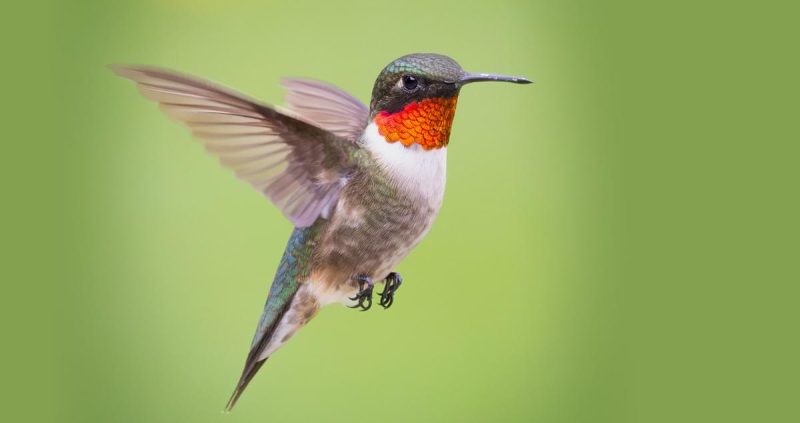
The Ruby-throated Hummingbird is the most common and widespread hummingbird species in Kentucky, and it is the only one that breeds in the state. Males are instantly recognizable by their dazzling, iridescent ruby-red throat patch, which shines brilliantly in sunlight, contrasting with their emerald-green backs and white underparts. Females lack the bright red throat, instead showing a pale, whitish throat with subtle streaks, but they share the same shimmering green plumage on the back. These hummingbirds are tiny, averaging about 3.5 inches in length with a wingspan of 4 to 4.5 inches, yet they display incredible strength and stamina for their size.
During the breeding season in Kentucky, Ruby-throated Hummingbirds are highly territorial, with males fiercely defending feeding territories around nectar-rich flowers or backyard feeders. They are known for their spectacular aerial displays, which include rapid dives and loops to impress females. Once courtship is over, females take on all nesting responsibilities, building delicate cup-shaped nests from plant down, lichens, and spider silk. The nests are often placed on slender tree branches, providing camouflage and safety for the eggs.
Their diet consists primarily of flower nectar, which provides them with quick energy, but they also eat small insects and spiders to meet their protein needs. This diet makes them essential pollinators in Kentucky’s natural ecosystems, as they transfer pollen between blooms while feeding. Homeowners who provide sugar-water feeders and brightly colored native flowers such as trumpet vine, bee balm, and cardinal flower are likely to attract them throughout spring and summer.
A fun fact about Ruby-throated Hummingbirds in Kentucky is their incredible migration journey. Despite their small size, these birds travel thousands of miles each year, with some individuals flying non-stop across the Gulf of Mexico to reach their wintering grounds in Central America. In Kentucky, they usually arrive in April and depart by late September, making them a beloved seasonal symbol of spring and summer.
Rufous Hummingbird (Selasphorus rufus)
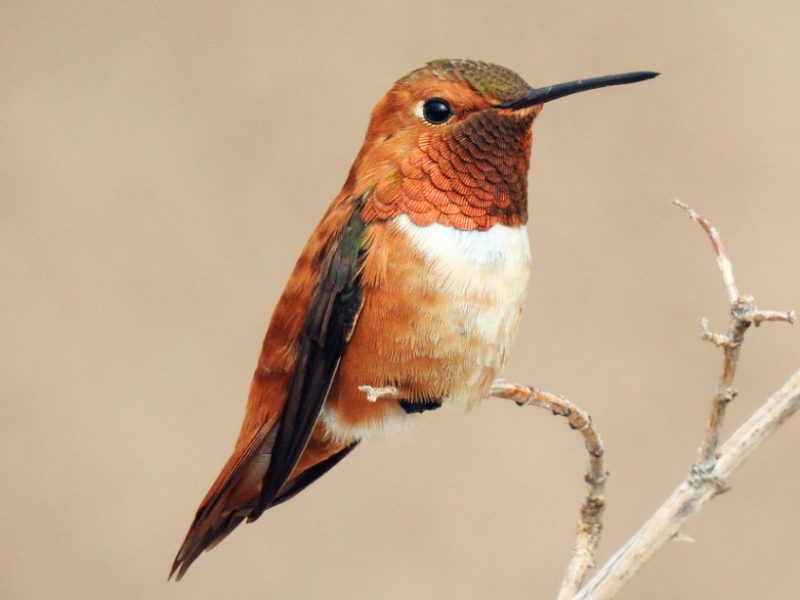
The Rufous Hummingbird is not a common sight in Kentucky, but it is one of the most frequently recorded western hummingbirds to wander eastward. Males are striking with their brilliant orange-red throats, rusty-orange backs, and flanks, while females are mostly green above with orange flanks and a few reddish spots on the throat. Slightly larger than the Ruby-throated Hummingbird, they measure around 3.5 to 4 inches in length with a wingspan of about 4.5 inches. Despite their small size, Rufous Hummingbirds are known for their extraordinary endurance and aggressive nature.
In Kentucky, Rufous Hummingbirds are usually seen during migration or in winter months when they occasionally appear at feeders. They are known as some of the most territorial hummingbirds in North America, often chasing away not only other hummingbirds but also much larger birds that dare to approach their food sources. Their aggressive behavior makes them fascinating to watch, though they can be a challenge for homeowners trying to support multiple hummingbirds at once.
Rufous Hummingbirds feed on nectar from flowers, especially tubular species, and will also readily visit backyard feeders stocked with sugar water. In addition to nectar, they consume small insects for protein. In Kentucky, sightings are often associated with well-maintained feeders during the colder months when food is scarce, making these unexpected visitors an exciting treat for birdwatchers.
A fun fact about Rufous Hummingbirds is that they hold the record for the longest migration route of any hummingbird in North America. They breed as far north as Alaska and western Canada and migrate south to Mexico for the winter. When they occasionally stray into Kentucky, they showcase just how far these tiny but powerful birds can travel, reminding observers of the resilience and adaptability of hummingbirds.
Black-chinned Hummingbird (Archilochus alexandri)
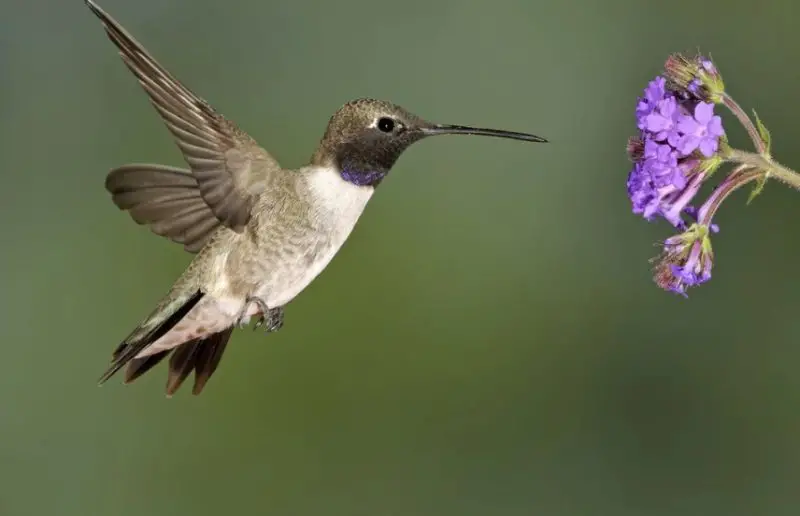
The Black-chinned Hummingbird is another rare visitor to Kentucky, typically found in the western and southwestern United States but occasionally appearing in the eastern states. This species is slightly larger than the Ruby-throated Hummingbird, measuring about 3.5 to 3.75 inches in length. Males are best identified by their velvety black throats with a narrow band of iridescent purple that shines when hit by sunlight, while females resemble female Ruby-throated Hummingbirds with their green backs and pale undersides. Because of this similarity, careful observation is required to distinguish them in Kentucky.
In terms of behavior, Black-chinned Hummingbirds are highly adaptable and can thrive in a wide range of habitats, from deserts and canyons in the West to suburban gardens when they wander east. In Kentucky, they are most likely to be seen at hummingbird feeders during migration periods. Like other hummingbirds, males display territorial aggression, performing dive displays to ward off rivals and attract females. Their flight style is often described as slightly more relaxed compared to the rapid wingbeats of Ruby-throated Hummingbirds, though they are equally capable of hovering and darting at remarkable speeds.
Their diet consists primarily of nectar, which they obtain from both native and ornamental flowers, and they also hunt small insects and spiders. Kentucky residents who encounter this rare species are often surprised to find them competing with Ruby-throated Hummingbirds at feeders. Black-chinned Hummingbirds are more tolerant of urban environments than some other species, which may explain why they occasionally wander eastward into Kentucky.
A fun fact about the Black-chinned Hummingbird is its distinctive vocalizations. While most hummingbirds produce high-pitched squeaks and chatters, this species is known for its rapid, dry “tik-tik-tik” call, which is quite different from the sounds made by the Ruby-throated Hummingbird. If one appears in Kentucky, an attentive ear may be the key to identifying this unusual visitor.
Broad-tailed Hummingbird (Selasphorus platycercus)
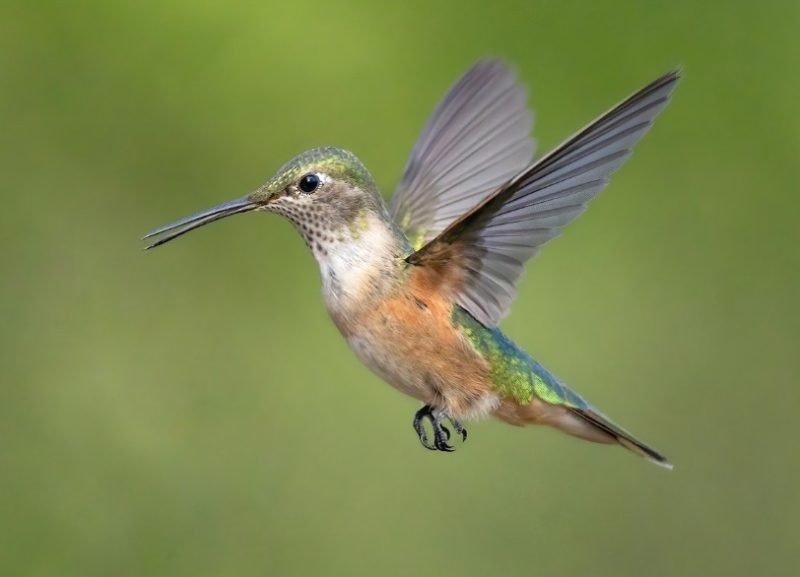
The Broad-tailed Hummingbird is a rare vagrant in Kentucky, usually found in the mountainous regions of the western United States. This species is slightly larger than the Ruby-throated Hummingbird, measuring about 3.75 to 4 inches in length with a wingspan around 5 inches. Males are easily recognized by their shimmering rose-magenta throats, bright green backs, and pale underparts. Females and juveniles lack the iridescent throat, instead displaying spotted throats with a more subdued appearance. One of their most notable identification features is their long tail, which produces a distinctive trilling sound in flight, making them unique among hummingbirds.
In Kentucky, sightings of the Broad-tailed Hummingbird are extremely unusual and usually occur during fall or winter when birds wander far outside their normal range. When they do appear, they are often reported at backyard feeders stocked with sugar water. Unlike the aggressive Rufous Hummingbird, Broad-tailed Hummingbirds are relatively calm in behavior, though males will still defend feeding territories during the breeding season in their native range. Their flight is graceful, and the metallic wing trill is often the first clue to their presence.
The Broad-tailed Hummingbird’s diet consists mainly of nectar from native wildflowers, and they also consume small insects such as gnats and aphids. In Kentucky, their feeding habits would be similar to those of Ruby-throated Hummingbirds, with a preference for trumpet-shaped blooms and artificial feeders. Because of their rarity, birdwatchers who encounter one in the state often document the sighting carefully, adding valuable information to birding records.
A fascinating fact about Broad-tailed Hummingbirds is their ability to withstand cold nighttime temperatures. In their typical mountain habitats, they enter a state of torpor, slowing down their metabolism to conserve energy. This adaptation allows them to survive chilly nights, which is unusual for most hummingbirds. If one shows up in Kentucky, it is a remarkable event, reminding bird enthusiasts of the species’ resilience and adaptability.
Calliope Hummingbird (Selasphorus calliope)
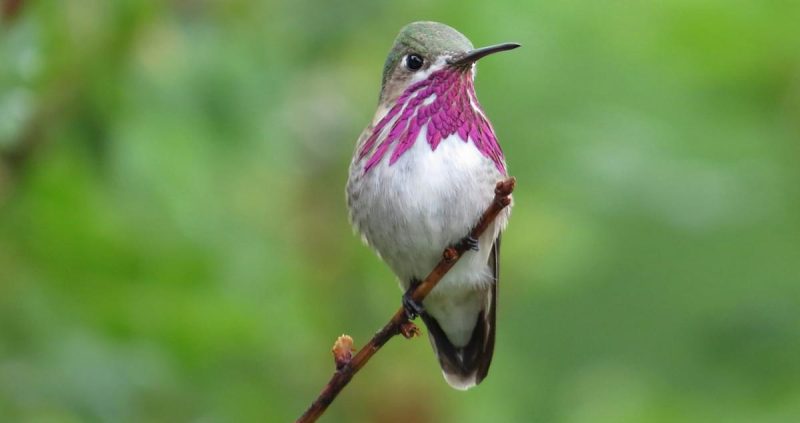
The Calliope Hummingbird holds the title of the smallest bird in the United States and is occasionally recorded in Kentucky as a rare winter visitor. Measuring only about 3 inches long with a wingspan of 4 to 4.3 inches, this species weighs less than a penny. Males are striking with their magenta streaked gorget that fans outward like rays of a star, while females and immatures are green above with peachy flanks and plain throats. Their tiny size combined with their colorful plumage makes them a favorite among birders lucky enough to spot one in Kentucky.
Behaviorally, Calliope Hummingbirds are surprisingly bold for their size. Males perform impressive courtship displays, hovering in front of females while fanning their throat feathers and producing buzzing flight sounds. Despite their delicate appearance, they are known to hold their ground against larger hummingbirds at feeders. In Kentucky, where they are only accidental visitors, they are most often observed at backyard feeders during colder months, providing a rare and exciting sighting for local birdwatchers.
Their diet consists mainly of nectar from small flowers, especially those suited to their short bills, and they supplement this with insects caught mid-air or plucked from spider webs. In Kentucky, they are drawn to nectar feeders in late fall or winter, where their presence is highly unusual. Because they are so small, they require frequent feeding to maintain energy levels, often visiting flowers or feeders dozens of times an hour.
A fun fact about the Calliope Hummingbird is that, despite being the tiniest bird in the U.S., it undertakes one of the longest migrations relative to body size of any bird in the world. Traveling from breeding grounds in the northwestern United States and Canada to wintering areas in Mexico, they cover thousands of miles. When one appears in Kentucky, it is a true marvel of endurance and resilience, underscoring the extraordinary abilities of hummingbirds.
Anna’s Hummingbird (Calypte anna)
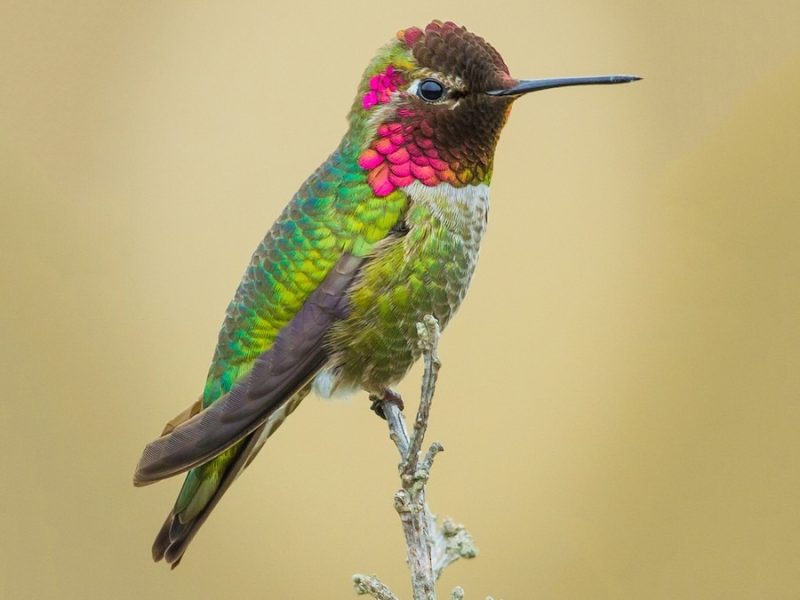
Anna’s Hummingbird is primarily a West Coast species, but a few individuals occasionally wander eastward, with rare sightings reported in Kentucky. Larger than most hummingbirds seen in the state, Anna’s measures about 3.9 to 4.3 inches in length with a wingspan of 4.7 inches. Males are spectacular with iridescent emerald bodies and a rose-pink gorget and crown that can appear almost glowing in direct sunlight. Females are green above with a pale underside and often show small pink spots on the throat. Their size and colorful plumage make them stand out among other hummingbirds when they appear in Kentucky.
In terms of behavior, Anna’s Hummingbirds are known to be adaptable and resilient, often remaining in their range year-round instead of migrating long distances like most other hummingbirds. When spotted in Kentucky, they are usually accidental visitors that show up at feeders during fall or winter. Unlike Ruby-throated Hummingbirds, which leave Kentucky in late September, Anna’s may linger longer if food is available. They are somewhat territorial and will aggressively defend their feeding spots from other hummingbirds.
Their diet, like that of other hummingbirds, is based on nectar, but Anna’s Hummingbirds are particularly flexible in their feeding habits. They are often seen sipping from ornamental flowers and backyard feeders, and they also consume insects to balance their diet. In Kentucky, they are most likely to be attracted to sugar-water feeders during the colder months, providing bird enthusiasts with rare winter sightings of a species typically associated with the Pacific Coast.
A fun fact about Anna’s Hummingbirds is their remarkable song. Unlike most hummingbirds, which only make short squeaks and chatters, Anna’s produces a long, complex series of buzzes, whistles, and chip notes, making them one of the most vocal hummingbird species. If one is spotted in Kentucky, it may even surprise observers with its unusual sounds, adding another layer of fascination to the encounter.
FAQs about Hummingbirds in Kentucky
What is the most common hummingbird in Kentucky?
The Ruby-throated Hummingbird (Archilochus colubris) is the most common and widespread hummingbird in Kentucky. It is the only species that regularly breeds in the state, arriving in spring and leaving by late September. Other species such as Rufous, Black-chinned, Broad-tailed, Calliope, and Anna’s Hummingbirds are considered rare or accidental visitors.
When do hummingbirds arrive and leave Kentucky?
Hummingbirds usually arrive in Kentucky around April when spring flowers begin to bloom. They remain throughout the summer and are most active from May to August. By late September and early October, most Ruby-throated Hummingbirds begin their migration south to Central America, though rare western species may occasionally appear later in the year.
What do hummingbirds eat in Kentucky?
Hummingbirds feed primarily on flower nectar, which provides quick energy, and they also eat small insects and spiders for protein. In Kentucky, they are attracted to native flowers such as trumpet vine, cardinal flower, and bee balm. Many homeowners also put out sugar-water feeders to supplement their diet, especially during migration.
Can hummingbirds survive Kentucky winters?
The Ruby-throated Hummingbird, Kentucky’s main species, does not stay for the winter. They migrate south before cold weather sets in. However, rare visitors such as the Rufous, Calliope, or Anna’s Hummingbird have been recorded in Kentucky during late fall or even winter, usually at feeders. These sightings are unusual and considered special events for birdwatchers.
How can I attract hummingbirds to my yard in Kentucky?
To attract hummingbirds, you can plant nectar-rich native flowers such as bee balm, trumpet vine, and columbine. Setting up a sugar-water feeder is also highly effective. The recommended ratio is one part white sugar to four parts water, with no food coloring added. Keeping feeders clean and placing them in a shaded area will help ensure hummingbirds return throughout the season.
What is a fun fact about hummingbirds in Kentucky?
One of the most fascinating facts is that the tiny Ruby-throated Hummingbird makes a non-stop migration flight across the Gulf of Mexico, covering up to 500 miles in a single journey. Despite their small size—only a few grams in weight—they accomplish one of the most impressive migratory feats of any bird visiting Kentucky.


